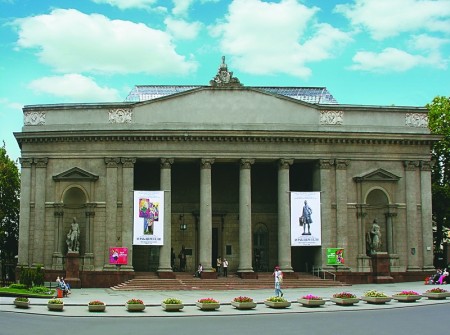A lot of art and architecture in Belarus goes back to
antiquity. There have been great efforts to preserve its fine arts in museums
and universities, the largest collection being held in the National Museum of
Art. The city of Vitebsk also houses many famous pieces and collections and has
historically been one of the artistic centers of Belarus, outside of Minsk.
The earliest forms of art can be dated back to the 14th
century with the Byzantine Empire. It’s mostly centered around manuscript
illustrations and iconography.
Another movement started after the October Revolution of
1917, where many revolutionary avant-guard artists started popping up around
Vitebsk.
Marc Chagall is thought to be one of the most influential
and famous Belarusian artists. He used several mediums, including stained
glass, which can be seen in several cathedrals, UN buildings, and the Jerusalem
Windows in Israel. He also made a name for himself in doing large-scale
paintings, like doing part of the ceiling of the Paris Opéra.
Chagall also utilized some of the styles found in Cubism, Symbolism, and
Surrealism. He merged these established
styles with his own styles, making him one of the most well-known Jewish artists
in Eastern Europe.
Belarusian literature also goes back centuries, and like
most early written literature, started out as mainly religious texts and
poetry. One of the most well-known poets of this era (11-13th
centuries) is Kiryla Turauski. Most people from Belarus at this time not only
write in the Belarusian language, but most also write in Latin, Polish, and/or
what’s called Church-Slavic (mostly used for liturgy in the Orthodox Church).
In the modern times, you’ll find writers using Russian as well.
The modern period of Belarusian literature started in the 19th
century, and one of the foremost authors was Yanka Kupala. Kupala left Belarus and lived in Vilnius (Lithuania)
and later in St. Petersburg. He had published a number of poems and books that
really irked the communist government, calling for his arrest at one point. He
died by falling down a flight of stairs in a hotel in Moscow in 1942. Some
speculate whether it really was an accident like it was documented as, or
whether it was a suicide or homicide.
Outside of Belarus, Vasil Bykaŭ is one of the most well-known
and most widely-read Belarusian author. Many of his works have been translated
into English and many other languages. During his youth, he fought for the Red
Army, his literature loved by many Soviets. In fact, he was even given the
title “People’s Writer of the Belarusian SSR.” However, Bykaŭ has spent many
years abroad because of his opposition to the Lukashenko
administration/dictatorship. He was able to return to his home in Belarus a
month before his death.
Theatre also plays an important role in Belarusian culture,
but it really didn’t take off until the 20th century. As a means of
freedom of expression, the Belarus Free Theatre was created in 2005, as well as
a number of underground theatre troops. Its main function is to serve as
pressure against government censorship and in support for the freedom of speech
and expression. Many authors, playwrights, actors, and musicians have been
arrested for performing pieces that the government feels are in opposition to
the establishment. This movement has brought these censorship issues to the
attention of many writers across the world.
Up next: Music and Dance





No comments:
Post a Comment